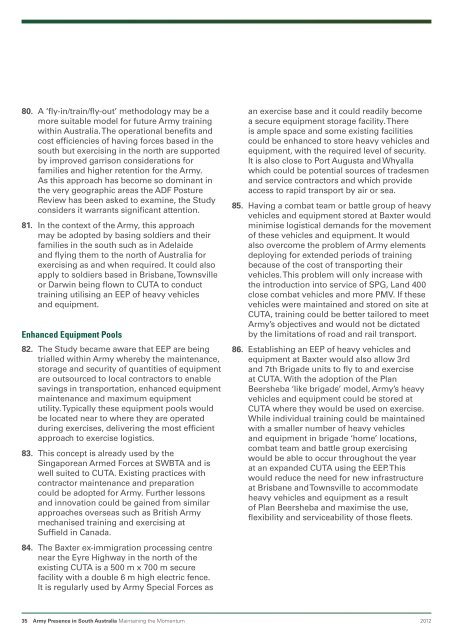ArMy PreSence in South AuStrAliA - Defence SA
ArMy PreSence in South AuStrAliA - Defence SA
ArMy PreSence in South AuStrAliA - Defence SA
Create successful ePaper yourself
Turn your PDF publications into a flip-book with our unique Google optimized e-Paper software.
80. A ‘fly-<strong>in</strong>/tra<strong>in</strong>/fly-out’ methodology may be a<br />
more suitable model for future Army tra<strong>in</strong><strong>in</strong>g<br />
with<strong>in</strong> Australia. The operational benefits and<br />
cost efficiencies of hav<strong>in</strong>g forces based <strong>in</strong> the<br />
south but exercis<strong>in</strong>g <strong>in</strong> the north are supported<br />
by improved garrison considerations for<br />
families and higher retention for the Army.<br />
As this approach has become so dom<strong>in</strong>ant <strong>in</strong><br />
the very geographic areas the ADF Posture<br />
Review has been asked to exam<strong>in</strong>e, the Study<br />
considers it warrants significant attention.<br />
81. In the context of the Army, this approach<br />
may be adopted by bas<strong>in</strong>g soldiers and their<br />
families <strong>in</strong> the south such as <strong>in</strong> Adelaide<br />
and fly<strong>in</strong>g them to the north of Australia for<br />
exercis<strong>in</strong>g as and when required. It could also<br />
apply to soldiers based <strong>in</strong> Brisbane, Townsville<br />
or Darw<strong>in</strong> be<strong>in</strong>g flown to CUTA to conduct<br />
tra<strong>in</strong><strong>in</strong>g utilis<strong>in</strong>g an EEP of heavy vehicles<br />
and equipment.<br />
enhanced equipment Pools<br />
82. The Study became aware that EEP are be<strong>in</strong>g<br />
trialled with<strong>in</strong> Army whereby the ma<strong>in</strong>tenance,<br />
storage and security of quantities of equipment<br />
are outsourced to local contractors to enable<br />
sav<strong>in</strong>gs <strong>in</strong> transportation, enhanced equipment<br />
ma<strong>in</strong>tenance and maximum equipment<br />
utility. Typically these equipment pools would<br />
be located near to where they are operated<br />
dur<strong>in</strong>g exercises, deliver<strong>in</strong>g the most efficient<br />
approach to exercise logistics.<br />
83. This concept is already used by the<br />
S<strong>in</strong>gaporean Armed Forces at SWBTA and is<br />
well suited to CUTA. Exist<strong>in</strong>g practices with<br />
contractor ma<strong>in</strong>tenance and preparation<br />
could be adopted for Army. Further lessons<br />
and <strong>in</strong>novation could be ga<strong>in</strong>ed from similar<br />
approaches overseas such as British Army<br />
mechanised tra<strong>in</strong><strong>in</strong>g and exercis<strong>in</strong>g at<br />
Suffield <strong>in</strong> Canada.<br />
84. The Baxter ex-immigration process<strong>in</strong>g centre<br />
near the Eyre Highway <strong>in</strong> the north of the<br />
exist<strong>in</strong>g CUTA is a 500 m x 700 m secure<br />
facility with a double 6 m high electric fence.<br />
It is regularly used by Army Special Forces as<br />
an exercise base and it could readily become<br />
a secure equipment storage facility. There<br />
is ample space and some exist<strong>in</strong>g facilities<br />
could be enhanced to store heavy vehicles and<br />
equipment, with the required level of security.<br />
It is also close to Port Augusta and Whyalla<br />
which could be potential sources of tradesmen<br />
and service contractors and which provide<br />
access to rapid transport by air or sea.<br />
85. Hav<strong>in</strong>g a combat team or battle group of heavy<br />
vehicles and equipment stored at Baxter would<br />
m<strong>in</strong>imise logistical demands for the movement<br />
of these vehicles and equipment. It would<br />
also overcome the problem of Army elements<br />
deploy<strong>in</strong>g for extended periods of tra<strong>in</strong><strong>in</strong>g<br />
because of the cost of transport<strong>in</strong>g their<br />
vehicles. This problem will only <strong>in</strong>crease with<br />
the <strong>in</strong>troduction <strong>in</strong>to service of SPG, Land 400<br />
close combat vehicles and more PMV. If these<br />
vehicles were ma<strong>in</strong>ta<strong>in</strong>ed and stored on site at<br />
CUTA, tra<strong>in</strong><strong>in</strong>g could be better tailored to meet<br />
Army’s objectives and would not be dictated<br />
by the limitations of road and rail transport.<br />
86. Establish<strong>in</strong>g an EEP of heavy vehicles and<br />
equipment at Baxter would also allow 3rd<br />
and 7th Brigade units to fly to and exercise<br />
at CUTA. With the adoption of the Plan<br />
Beersheba ‘like brigade’ model, Army’s heavy<br />
vehicles and equipment could be stored at<br />
CUTA where they would be used on exercise.<br />
While <strong>in</strong>dividual tra<strong>in</strong><strong>in</strong>g could be ma<strong>in</strong>ta<strong>in</strong>ed<br />
with a smaller number of heavy vehicles<br />
and equipment <strong>in</strong> brigade ‘home’ locations,<br />
combat team and battle group exercis<strong>in</strong>g<br />
would be able to occur throughout the year<br />
at an expanded CUTA us<strong>in</strong>g the EEP. This<br />
would reduce the need for new <strong>in</strong>frastructure<br />
at Brisbane and Townsville to accommodate<br />
heavy vehicles and equipment as a result<br />
of Plan Beersheba and maximise the use,<br />
flexibility and serviceability of those fleets.<br />
35 Army Presence <strong>in</strong> <strong>South</strong> Australia Ma<strong>in</strong>ta<strong>in</strong><strong>in</strong>g the Momentum 2012


